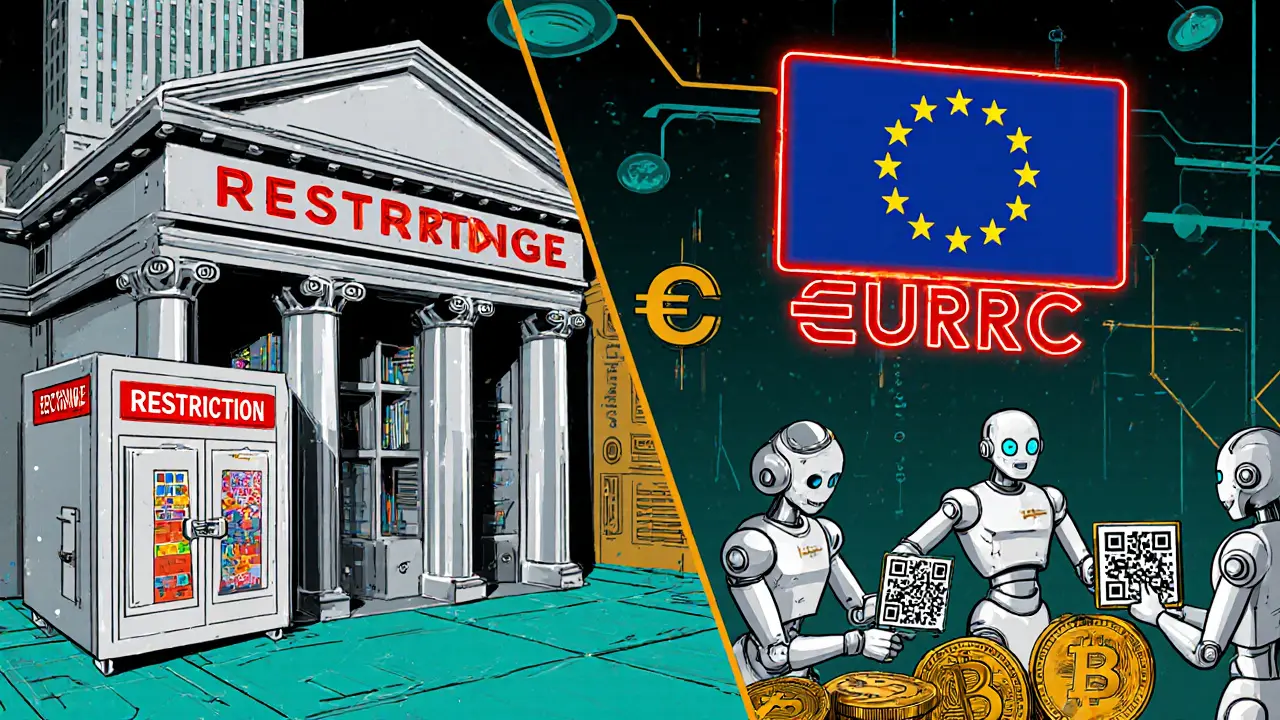Why Trading Volume Is Dropping After Crypto Restrictions
 Nov, 5 2025
Nov, 5 2025
Regulatory Impact Calculator
Estimate Your Trading Volume Impact
Enter your current trading volume and select your regulatory environment to see how restrictions affect your activity.
Estimated Monthly Volume:
Trading volume in cryptocurrency markets has been falling - not because people lost interest, but because governments changed the rules. In 2025, major exchanges like Crypto.com saw their spot trading volume plunge by over 60% in a single quarter. Meanwhile, Bitcoin hit new all-time highs. That doesn’t make sense - unless you understand what’s really happening behind the scenes.
Regulations Are Cutting Off Access, Not Demand
When the U.S. passed the GENIUS Act in mid-2025, it didn’t ban crypto. It forced exchanges to follow strict rules: stablecoins must be backed 1:1 with U.S. dollars, user verification got stricter, and certain tokens were banned outright. The result? Millions of users suddenly couldn’t trade the coins they used to. Crypto.com, which had been the second-largest exchange globally, dropped to eighth place. Why? Because it chose to comply - not flee.
Users didn’t disappear. They just got locked out. On Reddit, traders posted screenshots of their portfolios shrinking by 37% overnight as exchanges delisted popular altcoins. Trustpilot reviews for U.S.-based exchanges cratered from 4.3 to 2.5 stars. People weren’t angry about prices. They were angry about access.
Volume Isn’t Dead - It’s Moving
The global crypto market cap bounced back to over $4 trillion in mid-2025, even as spot trading volume on centralized exchanges fell 27.7% quarter-over-quarter. Where did the money go? It didn’t vanish. It shifted.
Stablecoins like USDT and USDC kept moving - over $1 trillion per month in transaction volume. But now, new players are rising. EURC, a euro-backed stablecoin built under the EU’s MiCA regulations, jumped from $47 million to $7.5 billion in monthly volume in just one year. Why? Because it’s legal. Institutions that couldn’t touch U.S.-based exchanges now trade EURC through licensed EU platforms. The volume didn’t disappear - it migrated to compliant channels.
Meanwhile, exchanges like MEXC, HTX, and Bitget grew. How? They moved their operations to places like the UAE, Singapore, and Hong Kong - regions with clearer, friendlier rules. Their users didn’t leave crypto. They just left the U.S. market.
It’s Not Just the U.S.
Regulatory pressure isn’t limited to America. India tightened tax reporting. The UK added new licensing fees. Some European countries delayed MiCA implementation, creating confusion. In markets with unclear rules, exchanges saw volume drops of over 22%. In places like Japan and Switzerland - where rules are stable and predictable - the drop was under 8%.
One trader in Zurich told me: "My volume dropped 15% when Swiss rules kicked in. But then I started trusting the system. I’ve traded more since than I ever did before." That’s the key difference: clarity beats chaos.

What About Bitcoin? Why Is It Rising?
Bitcoin rose over 30% in Q2 2025, even as trading volume on exchanges collapsed. Why? Because institutional money moved in - but not through exchanges. It flowed into regulated crypto ETFs. In one week, $5.95 billion poured into Bitcoin ETFs in the U.S. alone. These aren’t retail traders buying on Binance. These are pension funds, hedge funds, and asset managers buying through legal, SEC-approved channels.
Bitcoin became the only crypto that could survive this shift. Why? Because it’s the most understood, the most liquid, and the most regulated. Altcoins? Most don’t have the compliance infrastructure. So they got left behind. Bitcoin’s market share jumped from 42% to 60% in six months - not because it’s better, but because it’s the only one regulators didn’t try to shut down.
The Crime Drop That No One Talks About
Here’s the twist: the same regulations that cut trading volume also cut crime. In 2023, 0.9% of all crypto transactions were linked to illegal activity. By 2025, that dropped to 0.4%. That’s a 51% decline in illicit flows - the biggest improvement since crypto began.
TRM Labs, a blockchain analytics firm, says this isn’t a coincidence. Stricter KYC, transaction monitoring, and license requirements made it harder for criminals to move money. Exchanges that complied saw fewer scams, fewer wash trades, and fewer fake volumes. The market became cleaner - but also smaller, at least on the surface.

Who’s Winning? Who’s Losing?
Exchanges that stayed in the U.S. and followed the rules? They lost users. Crypto.com, Kraken, and Coinbase saw their spot volumes shrink. But they gained legal protection, institutional partnerships, and long-term stability.
Exchanges that moved offshore? They gained volume - but lost trust. Users in the U.S. can’t access them. Regulators might come after them later. They’re playing a game of cat-and-mouse.
Users? They’re caught in the middle. Those who wanted to trade freely now face barriers. Those who wanted safety now have it - but fewer options.
What Happens Next?
By late 2025, the worst of the volume drop is behind us. Exchanges have restructured. Users have adapted. ETFs are now the main gateway for institutions. Stablecoins are evolving into regulated financial tools.
Analysts at JPMorgan predict that by 2027, stablecoins will drive an extra $1.4 trillion in dollar demand. That’s not a small number. It means regulation isn’t killing crypto - it’s turning it into something bigger: a real part of the global financial system.
The drop in trading volume wasn’t a collapse. It was a pruning. Weak, risky, unregulated activity got cut. What’s left is slower, more cautious - but stronger.
If you’re still trading on an exchange that shut down half your portfolio in 2025 - you’re not alone. But if you’re holding Bitcoin, using EURC, or investing through ETFs - you’re already in the next phase. The market didn’t die. It grew up.